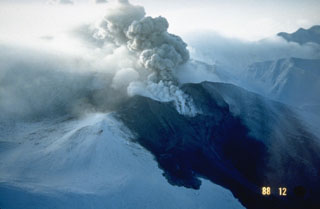Report on Tokachidake (Japan) — June 1989
Scientific Event Alert Network Bulletin, vol. 14, no. 6 (June 1989)
Managing Editor: Lindsay McClelland.
Tokachidake (Japan) Seismicity increases; no explosions
Please cite this report as:
Global Volcanism Program, 1989. Report on Tokachidake (Japan) (McClelland, L., ed.). Scientific Event Alert Network Bulletin, 14:6. Smithsonian Institution. https://doi.org/10.5479/si.GVP.SEAN198906-285050
Tokachidake
Japan
43.418°N, 142.686°E; summit elev. 2077 m
All times are local (unless otherwise noted)
Tephra produced by the phreatomagmatic explosions that began 19 December contained a little fresh magma (scoria and blocks) of basaltic andesite composition similar to that of the 1926 and 1962 ejecta. Some of the pyroclastic flows and surges melted snow and fed small lahars. A detailed description of this eruption can be found in Katsui (1989).
No eruptive activity has occurred since a brief explosion from crater 62-2 on 5 March. A continuous steam plume, which often contained ash in May but was white in June, was observed from Tokachi-dake Observatory. Plume heights reached 800 m above the crater rim in May and 100-600 m in June. A seismograph 4.5 km NNW of the crater recorded only five volcanic earthquakes and no volcanic tremor in May, but seismicity increased in late June (figure 5). A total of 25 volcanic earthquakes was recorded in June, and seismicity remained elevated as of early July.
Reference. Katsui, Y., ed., 1989, The 1988 eruption of Tokachi-dake, its sequence, mechanism, and influence on community: Report of Natural Disaster Scientific Research no. B-63-5, March 1989, 108 pp (8 papers).
Geological Summary. Tokachidake volcano consists of a group of dominantly andesitic stratovolcanoes and lava domes arranged on a NE-SW line above a plateau of welded Pleistocene tuffs in central Hokkaido. Numerous explosion craters and cinder cones are located on the upper flanks of the small stratovolcanoes, with the youngest Holocene centers located at the NW end of the chain. Frequent historical eruptions, consisting mostly of mild-to-moderate phreatic explosions, have been recorded since the mid-19th century. Two larger eruptions occurred in 1926 and 1962. Partial cone collapse of the western flank during the 1926 eruption produced a disastrous debris avalanche and mudflow.
Information Contacts: JMA.


